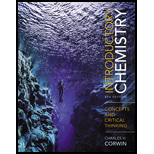
(a)
Interpretation:
The symbol of the third-period alkali metal is to be stated.
Concept introduction:
The elements in a modern periodic table are arranged in the increasing order of their
(b)
Interpretation:
The symbol of the third-period alkaline earth metal is to be stated.
Concept introduction:
The elements in a modern periodic table are arranged in the increasing order of their atomic numbers. In the modern periodic table, the horizontal rows are known as periods; whereas, the vertical columns are known as groups. There are
(c)
Interpretation:
The symbol of the rare earth element with the highest
Concept introduction:
The elements in a modern periodic table are arranged in the increasing order of their atomic numbers. In the modern periodic table, the horizontal rows are known as periods; whereas, the vertical columns are known as groups. There are
(d)
Interpretation:
The symbol of the lanthanide that is radioactive is to be stated.
Concept introduction:
The elements in a modern periodic table are arranged in the increasing order of their atomic numbers. In the modern periodic table, the horizontal rows are known as periods; whereas, the vertical columns are known as groups. There are
Want to see the full answer?
Check out a sample textbook solution
Chapter 5 Solutions
Introductory Chemistry: Concepts and Critical Thinking Plus MasteringChemistry with eText -- Access Card Package
- The atomic masses of the natural isotopes of neon are 19.99244u, 20.99395u, and 21.99138u . The average of these three masses is 20.99259u . The atomic mass of neon is listed as 20.1797u on the periodic table. Which isotope do you expect is the most abundant in nature? Explain. When neon gas is within an activated gas discharge tube, reddish-orange light is emitted.arrow_forwardWhich of the following are isotopes of element X, the atomic number for which is 9: 919X, 920X, 189X, and 921X?arrow_forwardA 10.02-g sample of an element contains 0.250mol of the element. Classify the element into the correct category of the representative, transition, inner-transition, or noble gas. Will the element conduct electricity?arrow_forward
- Need full explanation Classify each element as a representative element, transition metal, or inner transition metal. De, Ge, Rh, Ta, Am, Ra, Prarrow_forwardAccording to the general trend, the ionization energy for a group of elements (increases/decreases) proceeding up a group in the periodic table.arrow_forwardCopper has two natural isotopes: Cu63 and Cu-65. Which isotope is more abundant? (Hint: Refer to the periodic table.)arrow_forward
- 3 please answer and refer to the periodic tablearrow_forwardState the periodic law. How did the periodic law lead to the periodic table?arrow_forwardWhat class of elements lies along the “staircase” line in theperiodic table? How do their properties compare with those ofmetals and nonmetals?arrow_forward
- Horizontal rows in the periodic table are referred to by what two terms?arrow_forwardSome isotopes of iodine are radioactive, but others are not. When we speak of two isotopes of an element, we are referring to the fact that the two isotopes have different number of Group of answer choicesarrow_forwardWhen will ionization energy increases in the periodic table?arrow_forward
 Chemistry for Today: General, Organic, and Bioche...ChemistryISBN:9781305960060Author:Spencer L. Seager, Michael R. Slabaugh, Maren S. HansenPublisher:Cengage Learning
Chemistry for Today: General, Organic, and Bioche...ChemistryISBN:9781305960060Author:Spencer L. Seager, Michael R. Slabaugh, Maren S. HansenPublisher:Cengage Learning World of Chemistry, 3rd editionChemistryISBN:9781133109655Author:Steven S. Zumdahl, Susan L. Zumdahl, Donald J. DeCostePublisher:Brooks / Cole / Cengage Learning
World of Chemistry, 3rd editionChemistryISBN:9781133109655Author:Steven S. Zumdahl, Susan L. Zumdahl, Donald J. DeCostePublisher:Brooks / Cole / Cengage Learning Chemistry by OpenStax (2015-05-04)ChemistryISBN:9781938168390Author:Klaus Theopold, Richard H Langley, Paul Flowers, William R. Robinson, Mark BlaserPublisher:OpenStax
Chemistry by OpenStax (2015-05-04)ChemistryISBN:9781938168390Author:Klaus Theopold, Richard H Langley, Paul Flowers, William R. Robinson, Mark BlaserPublisher:OpenStax Introductory Chemistry: An Active Learning Approa...ChemistryISBN:9781305079250Author:Mark S. Cracolice, Ed PetersPublisher:Cengage Learning
Introductory Chemistry: An Active Learning Approa...ChemistryISBN:9781305079250Author:Mark S. Cracolice, Ed PetersPublisher:Cengage Learning Chemistry & Chemical ReactivityChemistryISBN:9781337399074Author:John C. Kotz, Paul M. Treichel, John Townsend, David TreichelPublisher:Cengage Learning
Chemistry & Chemical ReactivityChemistryISBN:9781337399074Author:John C. Kotz, Paul M. Treichel, John Townsend, David TreichelPublisher:Cengage Learning





